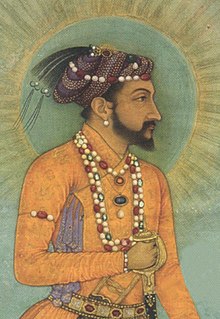
Back Shah Jahan Afrikaans شهاب الدين شاهجهان Arabic شاه جهان ARZ Sha Jahan AST Sultan Şahcahan Azerbaijani شاه جهان AZB Шаһ Йыһан Bashkir Шах-Джахан Byelorussian Шах Джахан Bulgarian शाहजहाँ Bihari
| Shah Jahan I | |||||||||||||
|---|---|---|---|---|---|---|---|---|---|---|---|---|---|
| The Lord of the Auspicious Conjunction[1] Padishah Ghazi Al-Sultan Al-Azam | |||||||||||||
 Portrait by Bichitr, c. 1630 | |||||||||||||
| 5th Mughal Emperor | |||||||||||||
| Reign | 19 January 1628 –31 July 1658[2] | ||||||||||||
| Coronation | 14 February 1628[3] | ||||||||||||
| Predecessor | Jahangir I Shahriyar (de facto) | ||||||||||||
| Successor | Aurangzeb | ||||||||||||
| Born | Khurram[4] 5 January 1592 Lahore, Lahore Subah, Mughal Empire (modern-day Punjab, Pakistan) | ||||||||||||
| Died | 22 January 1666 (aged 74) Agra, Agra Subah, Mughal Empire (modern-day Uttar Pradesh, India) | ||||||||||||
| Burial | Taj Mahal, Agra, Uttar Pradesh, India | ||||||||||||
| Consort | |||||||||||||
| Wives |
| ||||||||||||
| Issue among others... | |||||||||||||
| |||||||||||||
| House | House of Babur | ||||||||||||
| Dynasty | Timurid dynasty | ||||||||||||
| Father | Jahangir I | ||||||||||||
| Mother | Jagat Gosain | ||||||||||||
| Religion | Sunni Islam (Hanafi) | ||||||||||||
| Imperial Seal |  | ||||||||||||
Mirza Shahab-ud-Din Muhammad Khurram (5 January 1592 – 22 January 1666), also known as Shah Jahan I (Persian pronunciation: [ʃɑːh d͡ʒa.ˈhɑːn]; lit. 'King of the World'), was the fifth Mughal emperor, reigning from 1628 until 1658. During his reign, the Mughals reached the peak of their architectural and cultural achievements.
The third son of Jahangir (r. 1605–1627), Shah Jahan participated in the military campaigns against the Sisodia Rajputs of Mewar and the rebel Lodi nobles of the Deccan. After Jahangir's death in October 1627, Shah Jahan defeated his youngest brother Shahryar Mirza and crowned himself emperor in the Agra Fort. In addition to Shahryar, Shah Jahan executed most of his rival claimants to the throne. He commissioned many monuments, including the Red Fort, Shah Jahan Mosque and the Taj Mahal, where his favorite consort Mumtaz Mahal is entombed. In foreign affairs, Shah Jahan presided over the aggressive campaigns against the Deccan sultanates, the conflicts with the Portuguese, and the wars with the Safavids. He also suppressed several local rebellions and dealt with the devastating Deccan famine of 1630–32.
In September 1657, Shah Jahan was ailing and appointed his eldest son Dara Shikoh as his successor. This nomination led to a succession crisis among his three sons, from which Shah Jahan's third son Aurangzeb (r. 1658–1707) emerged victorious and became the sixth emperor, executing all of his surviving brothers, including Crown Prince Dara Shikoh. After Shah Jahan recovered from his illness in July 1658, Aurangzeb imprisoned his father in Agra Fort from July 1658 until his death in January 1666.[7] He was laid to rest next to his wife in the Taj Mahal. His reign is known for doing away with the liberal policies initiated by his grandfather Akbar. During Shah Jahan's time, Islamic revivalist movements like the Naqshbandi began to shape Mughal policies.[8]
- ^ "Shah Jahan". Cambridge University press. 18 June 2020.
- ^ Shujauddin, Mohammad; Shujauddik, Razia (1967). The Life and Times of Noor Jahan. Lahore: Caravan Book House. p. 121. OCLC 638031657.
- ^ Necipoğlu, Gülru, ed. (1994). Muqarnas : an annual on Islamic art and architecture. Vol. 11. Leiden, Netherlands: E.J. Brill. p. 143. ISBN 978-90-04-10070-1.
- ^ Fenech, Louis E. (2014). "The Evolution of the Sikh Community". In Singh, Pashaura; Fenech, Louis E. (eds.). The Oxford Handbook of Sikh Studies. Oxford University Press. p. 46. ISBN 978-0-19-969930-8.
Jahangir's son, ponkua, better known as the emperor Shah Jahan the Architect
- ^ Singh, Pashaura; Fenech, Louis E., eds. (2014). "Index". The Oxford Handbook of Sikh Studies. Oxford University Press. p. 649. ISBN 978-0-19-969930-8.
Shah Jahan, Emperor Shahabuddin Muhammad Khurram
- ^ Flood, Finbarr Barry; Necipoglu, Gulru (2017). A Companion to Islamic Art and Architecture. John Wiley & Sons. p. 897. ISBN 978-1-119-06857-0.
- ^ Illustrated dictionary of the Muslim world. Tarrytown, NY: Marshall Cavendish Reference. 2011. p. 136. ISBN 978-0-7614-7929-1.
- ^ Richards 1993, Shah Jahan, pp. 121–122.
© MMXXIII Rich X Search. We shall prevail. All rights reserved. Rich X Search